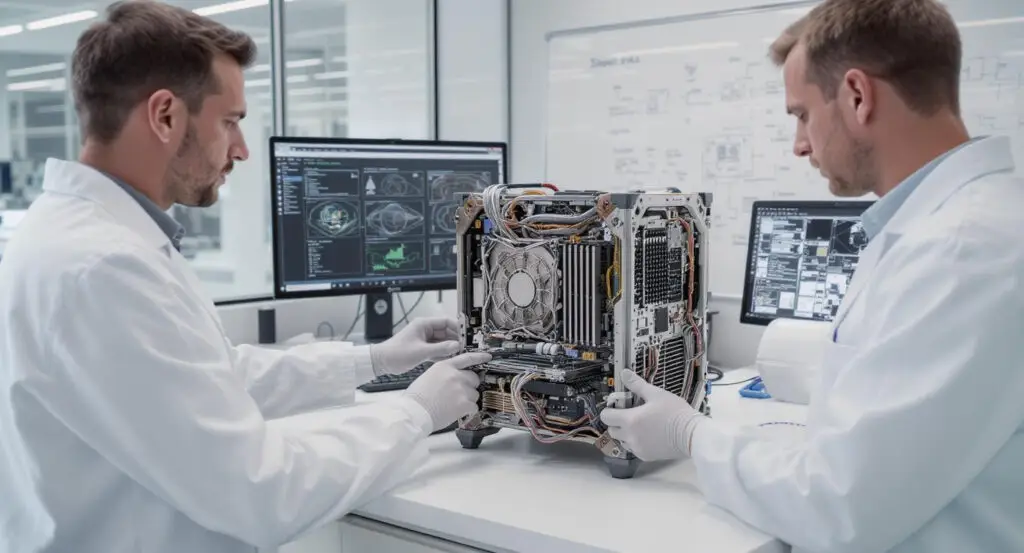In a landmark achievement for semiconductor technology, researchers at The Pennsylvania State University (Penn State) have unveiled the world’s first computer built entirely without silicon. Instead, the team successfully constructed a CMOS (Complementary Metal-Oxide-Semiconductor) computer using ultra-thin, two-dimensional (2D) materials offering a glimpse into a future where silicon’s decades-long reign in electronics may finally meet its match.
Described in a study published in Nature, the breakthrough is being hailed as a “milestone” by lead researcher Saptarshi Das, professor of engineering science and mechanics at Penn State. Das told PTI, “In the short term, you would like to augment silicon with these two-dimensional materials because they offer new functionalities, including in sensors and memory devices. This is why our paper is, I would say, a milestone, because it shows that it is possible in a way to replace silicon one day.”
The Material Revolution: From Bricks to Paper
Since the invention of the first silicon transistor in 1947, silicon’s ability to regulate electricity has underpinned the miniaturisation of technology. But as devices have grown ever smaller, silicon appears to have reached its limits.
“The trajectory of silicon has stalled,” Das explained, likening the challenge to construction. “If we need to construct a multi-storied building, we will use bricks. But now, what if I tell you that the best choice for this building is not bricks but paper, which is extremely thin? You can then get back all the good qualities you need to make a device very small.”
The Penn State team’s computer was crafted from molybdenum disulphide (MoS₂) and tungsten diselenide (WSe₂) materials well-known in the 2D community. According to lead author Subir Ghosh, a doctoral student at Penn State, the materials were grown over large two-inch wafers, making them scalable for potential industry adoption.
A Primitive Computer With Promising Performance
The 2D computer designed by the team is relatively primitive by today’s standards, akin to devices built by semiconductor foundries in the 1960s. It can perform a single instruction, dubbed “reverse subtract, skip if borrow,” which, when repeated, enables basic arithmetic operations like addition, subtraction, and multiplication.
“In order to subtract, you have two numbers. But while subtracting a bigger number from a smaller one, we need to ‘borrow.’ So, when a ‘borrow’ is raised, our computer will skip that instruction and move on to the next,” Ghosh explained.
Despite its simplicity, the computer demonstrated high drive current, low leakage, and low power dissipation, operating below three volts and at frequencies up to 25 kilohertz, according to the study.
A Global Race for Post-Silicon Solutions
Penn State’s achievement follows on the heels of similar efforts worldwide. Earlier this year, scientists at China’s Fudan University announced the creation of a RISC-V microprocessor chip assembled from 2D transistors, detailed in Nature in April. The chip consumed low power and offered further evidence that silicon alternatives are within reach.
Mayank Shrivastava, professor at the Indian Institute of Science (IISc) Bengaluru, who was not involved in the Penn State study, described the demonstration as “a watershed moment in the evolution of semiconductor technology.” He added, “While we have seen individual devices and simple circuits from 2D materials before, building an actual computer, even one with a single instruction set, completely from 2D semiconductors is a bold leap.”
Shrivastava emphasised that 2D materials, with their atomic-scale thickness and high mobility, could continue the spirit of Moore’s Law by delivering improved performance-per-watt, ultra-low leakage, and unprecedented device scaling.
Challenges on the Road to Commercialisation
Despite the excitement, Shrivastava cautioned that major hurdles remain before 2D computers can rival silicon in commercial applications. The operating speed of 25 kilohertz lags far behind modern silicon devices, and challenges persist in areas such as channel mobility, gate oxides, contact engineering, and device reliability.
Moreover, he noted that commercial viability will depend on building extensive infrastructure testbeds, fabrication facilities, tooling ecosystems, and skilled workforces that many countries currently lack.
Nonetheless, the achievement is seen as a foundational advance. “It is a milestone that, over time, has historically driven transformative changes,” Shrivastava said.
In recognition of these breakthroughs, India’s electronics and IT ministry is reportedly exploring funding for further research on 2D materials, with plans to solicit project proposals in the coming months.
As the silicon age shows signs of nearing its twilight, the global race to define the next era of electronics is clearly underway.























